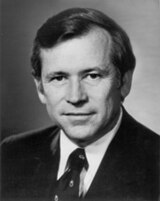| 98th United States Congress | |
|---|---|
97th ← → 99th | |
 United States Capitol (1980) | |
January 3, 1983 – January 3, 1985 | |
| Members | 100 senators 435 representatives 5 non-voting delegates |
| Senate majority | Republican |
| Senate President | George H. W. Bush (R) |
| House majority | Democratic |
| House Speaker | Tip O'Neill (D) |
| Sessions | |
| 1st: January 3, 1983 – November 18, 1983 2nd: January 23, 1984 – October 12, 1984 | |
The 98th United States Congress was a meeting of the legislative branch of the United States federal government, composed of the United States Senate and the United States House of Representatives. It met in Washington, D.C., from January 3, 1983, to January 3, 1985, during the third and fourth years of Ronald Reagan's presidency. The apportionment of seats in the House of Representatives was based on the 1980 U.S. census.
Contents
- Major events
- Major legislation
- Party summary
- Senate
- House of Representatives
- Leadership
- Senate 2
- House of Representatives 2
- Caucuses
- Members
- Senate 3
- House of Representatives 3
- Changes in membership
- Senate 4
- House of Representatives 4
- Committees
- Senate 5
- House of Representatives 5
- Joint committees
- Employees
- Legislative branch agency directors
- Senate 6
- House of Representatives 6
- See also
- Notes
- References
- External links
The Republicans maintained control of the Senate, while the Democrats increased their majority in the House of Representatives from the 97th Congress.













